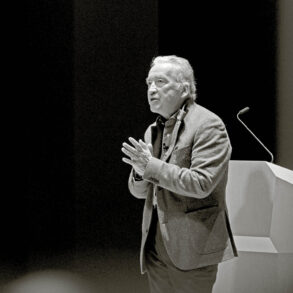What is bright yellow, eats oats as its favourite food, does not like coffee, learns without a brain – even composes music 1, feels without nerves, moves without legs, heals itself, has 719 sexual partners with whom it can mate 2, can share its knowledge with others of its kind, and yet is neither a plant nor an animal nor a fungus? What recently even serves as a power source for a wristwatch with a heart rhythm monitor? 3
Allow me to introduce you to the ‹blob›. This being shares characteristics with three great kingdoms of life: it eats and seems to think like an animal, reproduces like a mushroom, and is coloured like a plant. Its Latin name is Physarum polycephalum (multi-headed) and it is a so-called slime mould. Blobs are not normal moulds that would be classified as fungi but they form a world of their own: they are now classified as protists, which means ‹none of the above›. Blobs have become a popular subject of current scientific study, and the list of their capabilities is growing rapidly. The name blob comes from a 1950s horror film starring Steve McQueen, in which a flesh-eating alien amoeba slime grows to monstrous proportions and becomes redder and redder as it devours the inhabitants of a town. The blob begins its life as many individual cells, each with a single nucleus. Then they fuse to form a plasmodium, the vegetative life stage in which the organism that has become unicellular feeds and grows. How did the blob manage to capture the imagination – and the financial resources! – of scientists and scholars?
The Most Powerful Network
In 2000, the Japanese biologist Toshiyuki Nakagaki 4 took a sample of the blob, which normally thrives in the damp, shady parts of forests. He placed the creature, which was in the so-called plasmodium stage, at one end of a maze and put its favourite food, oats, at the other. Then he observed what happened. The blob spread out in its typical way: a pulsating, rhythmical flow – a single cell with many nuclei floating in the almost transparent, thin film of what is called cytoplasmic fluid. The flowing movement called cytoplasmic flow was not homogeneous. Veins reached out – also called pseudopodia (little feet) – which soon covered all the paths of the maze. When the blob encountered the food source, it strengthened precisely those vein connections leading to that source. This happened through a subtle feedback process in which the pulsating movement seemed to play an important role. The pulsating was not only for nutrition and locomotion, but also for communication and coordination. An optimisation of the network then occurred: connections that were not linked to food became smaller and eventually disappeared.
In this way, Nakagaki even managed to recreate the Japanese railway network around Tokyo, one of the best-designed in the world, simulating the nodes of the stations with oats of different sizes – depending on the population. The blob replicated the railway network almost exactly, with the difference that the slime mould version was more robust against damage because if one connection was broken, the rest of the network could continue to function. Another research team 5 found that the blob can efficiently solve the ‹travelling salesman problem› – finding the shortest route to visit a series of cities only once each.

In the Land of the Surface
The pulsating current seems to lie at the heart of the blob’s intelligence, especially the mystery of learning and memory. In a more recent paper 6, for example, it was shown that these oscillations are extraordinarily similar to those of a brain, except that they are a hydrodynamic system rather than electrical signals – perhaps similar to the rhythms of the cerebrospinal fluid, although I do not think the latter have been studied in this way before.
If you watch one of the many YouTube films about blobs, what is most striking is the dendritic, flowing, expansive movement in which more or less synchronous waves travel as the blob pulsates with its complex rhythms. It feels – and we are reminded of this by the classification problems mentioned at the beginning – as if today’s categories somehow don’t fit. For the blob lives in an essentially two-dimensional world of the ‹flatlands›, where above and below have little meaning. A world that could be a remnant of times long past; that is to say, perhaps of a time before heaven and earth separated and neither substance existed as it does today.
The Seat of Intelligence
Does all this help us to better understand memory, learning, and intelligence? The process in finding a way through the maze is first to seek a totality and then to move from the whole via the context to the individual problem, from the periphery to the centre: there is something holistic about the gesture.
Blobs are among the oldest and simplest life forms ever to be endowed with intelligence. An intelligence without a brain. It’s a similar story with plants, after all: they demonstrate intelligence – perhaps based in the tips of the roots – without a brain. But in the case of the blob, it stands out and raises the question quite glaringly: does the seat of our intelligence really lie only in the brain, as we still largely understand it today, or does its origin lie much deeper, more dispersed than we have hitherto assumed?
Translation Christian von Arnim
Title image Blob in the nature. Photo: Björn S, CC 2.0
Footnotes
- S Venkatesh, E Braund & ER Miranda, Composing Music with Bio-Technology: An Intelligent Algorithmic Composition System Using Physarum polycephalum-based Memristors. In: Unconventional Computing, Arts, Philosophy, Volume 2, 535–555. World Scientific, 2022.
- The ‹blob›: Paris zoo unveils unusual organism which can heal itself and has 720 sexes.
- J Lu & P Lopes, Integrating Living Organisms in Devices to Implement Care-based Interactions. In: Proceedings of the 35th Annual ACM Symposium on User Interface Software and Technology 1–13. Association for Computing Machinery, 2022. doi:10.1145/3526113.3545629.
- T Nakagaki, H Yamada & A Tóth, Maze-solving by to amoeboid organism. Nature 407, 470–470. 2000.
- F MacDonald, An Amoeba Just Found an Entirely New Way to Solve a Classic Computing Problem. ScienceAlert, 2018.
- A Boussard et al., Adaptive behaviour and learning in slime moulds: the role of oscillations. Philosophical Transactions of the Royal Society B: Biological Sciences 376, 20190757. 2021.










The brain is in my cranium, intelligence is everywhere, always present. How much access to this intelligence I have using my brain is the question. The brain doe not create intelligence, can only access it. At sleep, brains sleeps also, so … where is the intelligence the established science says that the brain creates? Please think !